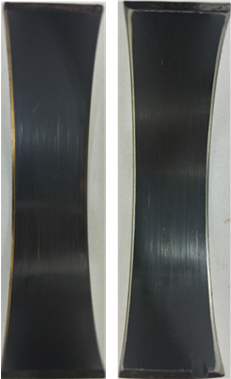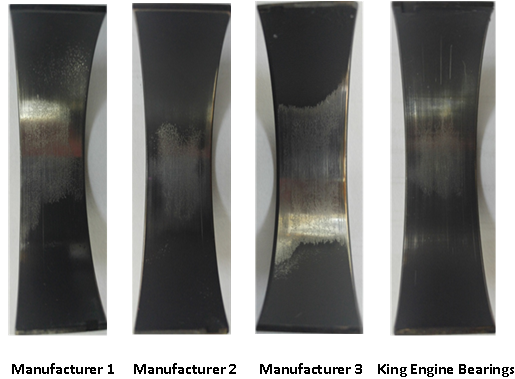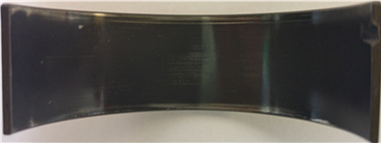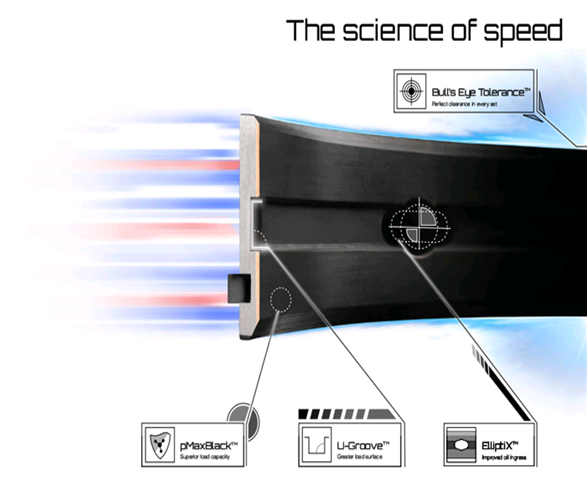Main page
About us
Sliding Bearings Consulting
Advertising Opportunities

SubsTech’s sister website Smooth Sliding provides independent engineering consulting services that help you to solve engine bearing related issues: failures, material selection, geometry design and optimization of hydrodynamic conditions.
Smooth Sliding is an engineering consulting company run by Dr. Dmitri Kopeliovich:
- VP R&D of King Engine Bearings.
- World leading expert (32 years of experience) in design, technology and materials for Engine bearings in applications such as automotive, renewable energy, aviation, racing and others.
- Founder and owner of SubsTech (Substances & Technologies) – a leading professional website on Materials Science and Engineering.
- Author of numerous scientific and engineering publications and patents.
- Founder and owner of Smooth Sliding.
For further information and for requesting consulting services please visit our sister website Smooth Sliding.
to Metals
to Engine bearings
Polymer Coated Bearings
Introduction
Most of the time, engine bearings work in the regime of hydrodynamic lubrication. As such, the bearing surface is separated from the crankshaft surface by the oil film generated from shaft rotation. However, due to continuous developments in the design of internal combustion engine, the typical minimum values of oil film are getting smaller and smaller. In addition, extreme race conditions, especially in drag racing, may cause metal to metal contact between bearing and shaft. Such contact requires material with better anti friction properties.
The factors responsible for this tendency are:
- more compact design of the engine
- start-stop technology
- use of low viscosity oils
- greater engine output
Engine evolution is well illustrated by the history of the Chevrolet small-block V8. The first generation (1955) had a displacement of 265 cu. in. and an output of 180 hp. This means that each cubic inch of displacement produced 0.68 hp. 50 years later GM offered its LS9 supercharged small block engine having a displacement of 376 cu. in. (6.2 L) and a maximum of 638 hp. This is equivalent to 1.7 hp/cu. in. – an increase of 150%.
Additionally, engine designers are required to reduce fuel consumption in compliance with more strict governmental regulations. Consequently, the use of low viscosity motor oils has become commonplace. In hydrodynamic friction, energy loss lessens with the decrease of oil viscosity.
High loads applied to the bearings, combined with a low viscosity lubricant, result in a reduction of the minimum oil film thickness. This may cause a metal-to-metal contact between the bearing and the shaft. Such contact is characterized by a high coefficient of friction (power loss), increased wear, possibility of seizure between the bearing and shaft materials, and a non-uniform distribution of the bearing load. The situation is further aggravated by the distortions of a lightweight crankshaft (due to the loads applied to it) and of lightweight connecting rods. The big end of the rods changes the shape of its bore - and the bearings mounted in it - from circular to elliptical (due to inertia forces at high rotation speeds).
Substantial fuel economy and pollution reduction are achieved in start-stop engines. However, a start-stop system produces undesirable conditions for engine bearing operation. A hydrodynamic regime of lubrication is stable only within a certain range of rotation speed. If the speed drops down, the hydrodynamic force decreases and becomes insufficient for counteracting the load applied to the bearings. Metal-to-metal contact ensues and the bearing material wears faster than in the hydrodynamic regime. Since start-stop engines shut down and restart very frequently (10 times more frequently than classic engines), the bearings operate in a condition of mixed lubrication (with metal-to-metal contact) much more of the time.
Such conditions require bearing materials with greatly enhanced anti-friction properties.
to top
Development of Polymer Coatings
Lack of liquid lubricant (oil) during mixed lubrication may be compensated by Solid lubricants distributed in the form of fine particles within a polymer matrix. The resulting material is then applied to serve as the top layer of the engine bearings. Such coatings may also contain particles of reinforcing phase added for greater strength and wear resistance.
The main purpose of coatings in conventional existing applications is to provide some protection from overlay wear during mixed lubrication regimes. For example, coatings prevent cold start wiping. Coatings prolong bearing life when operating with very thin or negligible oil films. However, the true potential and benefits of coatings are quite underestimated. They can play a much more important role in preventing seizure and reducing wear of highly loaded bearings.
Similar to oil film, a polymer coating separates the metallic bearing material from the crankshaft surface. Therefore, in the system of bearing/lubricant/journal, the polymer coating may be referred to as either lubricant or bearing material.
According to this method of approach, there are two possible concepts of polymer coatings:
A. A temporary sacrificial layer of lubricant wearing off in the bearing conforming process
B. A permanent bearing overlay maintained for the entire bearing service life
When starting the process of developing polymer based coatings, the following key bearing material properties must be targeted:
- Anti-friction properties – a combination of surface soft properties: low coefficient of friction, conformability (the ability of the bearing material to accommodate geometry irregularities of the bearing, its housing or journal), seizure resistance (the ability of the bearing material to resist physical joining with the journal material) and embedability (the ability of the bearing material to absorb small foreign particles).
- Wear resistance - the ability of the bearing material to maintain its dimensional stability under conditions of intermittent direct contact between the bearing and journal materials.
- Toughness and impact resistance – ability to absorb energy without fracturing.
- Fatigue strength - the maximum value of cycling stress that the bearing can withstand after an infinite number of cycles.
The polymer base of the coatings must be thermostable (able to resist irreversible change in its chemical or physical structure) at temperatures up to 500°F. It should also be strong and wear resistant. However, the polymer by itself can not be used as a bearing coating. Its antifriction and mechanical properties should be enhanced by dispersion of various additives.
Antifriction properties of the coating material may be dramatically enhanced by the addition of particles of solid lubricants.
King newly developed polymer coating contains the abrasive particles of optimal dimension which produce the maximum effect on the wear resistance needed.
Fatigue strength of a material is determined by the properties, contents and dimensions of all constituents of the composite material. The high load capacity (fatigue strength) of King polymer coatings is guaranteed by a balanced combination of a strong polymer matrix and the sum of its additives.
It is very important to achieve homogeneous distribution of all additives in the polymer matrix. A special technology preventing sedimentation of heavy particles in a liquid polymer composition has been developed by King.
to top
King Polymer Coatings
Polymer coatings developed by King Engine Bearings are composed of different types of inorganic and ceramic additives dispersed in a polymer matrix. The additives have nano-dimensions. Therefore the coating material may be defined as a polymer ceramic nano-composite.

Fig.1 King polymer coated bearings
Three different types of polymer coatings for different applications have been developed by King Engine Bearings: K-340, K-334 and K-40.
- K-340
K-340 is a strong coating, offering exceptional Wear resistance, Toughness and Fatigue strength. It was designed for applying over relatively hard substrates: bronze, Aluminum alloys, sputter overlay], and [[Bearing Materials For Race Engines#SV Material For Extreme Load|King silver overlay. Hardness of the coating is about 46 HV which is harder than most aluminum bearing alloys. The coating is able to operate under loads up to 17,400 psi (120 MPa) in diesel direct injection engines, turbocharged gasoline engines, racing engines, start-stop and hybrid engines, and in conventional passenger car engines replacing Babbitt plated tri-metal bearings. Coated bearings tested at 11,600 psi (80 MPa) for 24 hrs. are depicted in Fig.2.

Fig.2 Tested bearings coated with K-340 wear resistant coating
left – steel-bronze bearing, right – steel aluminum bearing
The bearings retained their coating after the test, proving the outstanding wear resistance of K-340 material.
- K-334
K-334 is a wear resistant coating for applying over relatively soft substrate. It was developed for coating tri-metal pMax Black XP high performance bearings. The coating helps to improve XP bearing wear resistance under conditions of metal-to-metal contact. It also increases the resistance of tri-metal bearings to cavitation erosion. K-334 is not a sacrificial coating. In contrast to other coated bearing manufacturers and suppliers, King coatings do not change oil clearance. The wall thickness of King coated bearings is equal to that of the non-coated versions.
A performance comparison of polymer coated tri-metal race bearings, from four leading bearing manufacturers/suppliers, under the regime of metal-to-metal contact is presented in Fig.3.

Fig.3 Bearings tested in King Test Rig in mixed lubrication regime at 10,150 psi for 24 hrs.
Two conclusions can be made from the tests:
- The wear rate of King K-334 coating is the least of the four tested manufacturers
- The fatigue strength of King pMax Black XP bearings is greater than that of competitive materials, which have clear fatigue cracks in the overlay
- K-40
K-40 is a soft version of coating. It is sacrificial, with excellent conformability and anti-friction properties. This coating composition was designed specially for engines experiencing continuous metal-to-metal contact. This is characteristic of the extreme loading and conditions found in drag racing. The image of a bearing tested under continuous direct contact with the journal is depicted in Fig.4.

Fig.4 King aluminum alloy HP bearing coated with K-40 after direct friction test
The bearing appearance proves the ability of K-40 to withstand the conditions of direct friction.
to top
Conclusions
- King coatings are polymer ceramic nano-composites combining lubrication properties with excellent wear resistance, toughness, fatigue strength and cavitation resistance.
- K-340 coating is for applying directly onto relatively hard substrate: bronze or aluminum intermediate layers, sputter or silver overlays
- K-340 material has proven, outstanding wear resistance
- K-334 is a coating developed for King tri-metal pMax Black race bearings
- K-334 coated bearings demonstrated superior wear resistance and fatigue strength among bearings from four leading manufacturers/suppliers
- K-40 is the softest King coating. It has demonstrated exceptional ability to work under continuous direct friction conditions
Related internal links
to Metals
to Engine bearings



